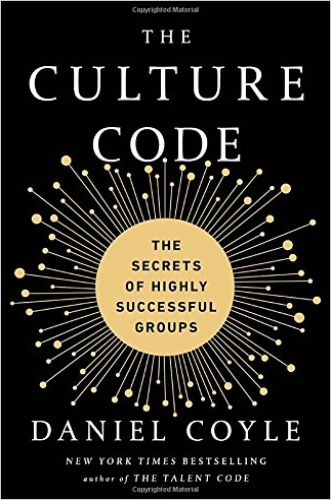Daniel Coyle’s New York Times bestseller details how successful organizations build mutual trust, vulnerability and communication.

Build Your Culture
In this New York Times bestseller – a Bloomberg and Library Journal Best Book of the Year – Daniel Coyle explains why creating a strong team culture requires the skills to “build safety,” “share vulnerability” and “establish purpose.”
Culture is a set of living relationships working toward a shared goal. It’s not something you are. It’s something you do.Daniel Coyle
After four years of research, Coyle brings his ideas alive with anecdotes and real-world examples that captivate and inform. His examples show the Pixar movie studio producing hits, the San Antonio Spurs winning five NBA championships under coach Gregg Popovich, restaurateur Danny Meyer launching 24 successful restaurants and US Navy SEAL teams operating in dynamic unison on dangerous missions.
Business leaders and students will gain useful, applicable insights about team-building and corporate culture from Coyle’s report.
“Belonging Cues”
Successful groups share chemistry through what scientists describe as belonging cues, which convey that group members have become secure with each other through physical closeness, sustained eye contact, positive energy, welcoming body language and inclusion. The cues create psychological safety, which is important to high-performing groups. They thrive on behavior that says, “You are safe and connected.”
Here Coyle demonstrates the core of his research: Simple human virtues drive success since everyone seeks and needs to feel peer acceptance.
Exchanges of vulnerability, which we naturally tend to avoid, are the pathway through which trusting cooperation is built.Daniel Coyle
Leaders should listen intently and “overcommunicate” to affirm what they hear. Coyle urges you to thank people excessively, hire with care, give every employee a voice and “embrace fun,” because laughter signals social safety. When your brain receives belonging cues, your amygdala forges social bonds strengthened by repeated signals over time.
Proximity and Connection
Zappos, the online shoe retail outlet that the late founder Tony Hsieh sold to Amazon in 2009, enjoys the reputation of having an amazing corporate culture. Hsieh focused it on “collisions” – serendipitous staff interactions that foster creativity, collaboration and growth. Coyle cites MIT professor Thomas Allen, who discovered how the location of group members’ desks facilitates communication, connection and success.
Cohesion happens not when members of a group are smarter but when they are lit up by clear, steady signals of safe connection.Daniel Coyle
Coyle highlights the research gems he diligently uncovered, but unlike many authors, he never belabors the data. Instead, he consistently uses it to illuminate the emotional underpinnings of group success.
Vulnerability
To build vulnerability, leaders must demonstrate their own weaknesses, listen openly, avoid stating conclusions at the beginning of a discussion and talk about hard truths.
Good listening is about more than nodding attentively; it’s about adding insight and creating moments of mutual discovery.Daniel Coyle
Vulnerability precedes trust; trust doesn’t beget vulnerability. Conveying vulnerability through brief social interactions sends the clear signal that you would appreciate help. In a bonded culture, the receiver empathizes with your admission of weakness and offers you assistance.
Team Coherence
Group members who endure challenging circumstances together show vulnerability and work as a team. Coyle describes how US Navy SEAL team trainees undergo a Hell Week that features four-mile ocean swims, 10-mile runs and other grueling exercises. All training is team-based and forgoes the usual hierarchy between officers and enlisted men. In one grueling test, for example, six trainees lift a telephone pole as a group and run together while carrying it. Coyle describes how – by necessity – this fosters vulnerability and cooperation.
Leaping into the unknown, when done alongside others, causes the solid ground of trust to materialize beneath our feet.Daniel Coyle
SEAL Dave Cooper, for example, created highly successful teams by overcoming authority bias. He generated cues that drew group members toward connection and cooperation. He eliminated titles and continually asked team members for input.
In March 2011, Cooper and another Team Six leader started training teams to take out al-Qaeda leader Osama Bin Laden. Cooper had concerns about stealth helicopters and relentlessly trained his team for downed-helicopter scenarios. As he feared, one of the team’s helicopters crashed during the mission. Cooper’s teams carried on without a hitch.
Purpose
Group members cohere around mutual purpose and shared goals. High-purpose environments nurture this togetherness with repeated, small signals that link the group’s ongoing activities with its stated objectives.
When you watch highly cohesive groups in action, you will see many moments of fluid, trusting cooperation.Daniel Coyle
How quickly a team learns and improves indicates the success of its culture. For example, Harvard researchers measured and compared how fast 16 surgical teams learned a new heart surgery technique. Teams that learned quickly and efficiently shared the strongest sense of purpose. They framed procedures as learning opportunities that would benefit patients and the hospital. Team leaders explained to members how their individual roles contributed to the team’s success. They practiced new techniques and then analyzed their performance after every surgery. Coyle also cites the efficacy of frank, post-event discussions.
Consistent Performance
Coyle advises that you can foster a high-creativity environment by encouraging creative skills and inspiring your team to build something new. He cites “creative engineer” Ed Catmull, president and co-founder of Pixar, who views innovative projects as cognitive challenges entailing thousands of choices and ideas. As creative leader, Catmull oversees a production team’s dynamics, protects its autonomy, and provides the tools it needs to make mistakes, regroup and design the best product.
Glue and Inspiration
Coyle explores high-performance groups to reveal how their skills build unity and collaboration, proficiencies every organization needs. He writes in an engaging, accessible voice that only occasionally descends into gee-whiz boosterism. His admiration for the organizations he cites might blind him slightly to the larger implications of, for example, Google’s relentless quest for profit.
Creating engagement around a clear, simple set of priorities can function as a lighthouse, orienting behavior and providing a path toward a goal.Daniel Coyle
Coyle seeks to illuminate cohesion and inspiration; he does a remarkable job of finding and explaining both. Large companies, two-person partnerships and all organizations in between will find revelations in applying the techniques Coyle discovers and details.
Daniel Coyle also wrote Lance Armstrong’s War; The Little Book of Talent: 52 Tips for Improving your Skills; The Talent Code: Greatness Isn’t Born. It’s Grown. Here’s How; and Hardball: A Season in the Projects.





